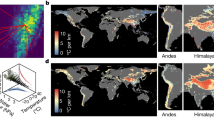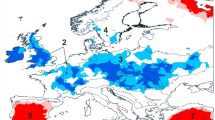Abstract
The ranges of plants and animals are moving in response to recent changes in climate1. As temperatures rise, ecosystems with ‘nowhere to go’, such as mountains, are considered to be more threatened2,3. However, species survival may depend as much on keeping pace with moving climates as the climate’s ultimate persistence4,5. Here we present a new index of the velocity of temperature change (km yr-1), derived from spatial gradients (°C km-1) and multimodel ensemble forecasts of rates of temperature increase (°C yr-1) in the twenty-first century. This index represents the instantaneous local velocity along Earth’s surface needed to maintain constant temperatures, and has a global mean of 0.42 km yr-1 (A1B emission scenario). Owing to topographic effects, the velocity of temperature change is lowest in mountainous biomes such as tropical and subtropical coniferous forests (0.08 km yr-1), temperate coniferous forest, and montane grasslands. Velocities are highest in flooded grasslands (1.26 km yr-1), mangroves and deserts. High velocities suggest that the climates of only 8% of global protected areas have residence times exceeding 100 years. Small protected areas exacerbate the problem in Mediterranean-type and temperate coniferous forest biomes. Large protected areas may mitigate the problem in desert biomes. These results indicate management strategies for minimizing biodiversity loss from climate change. Montane landscapes may effectively shelter many species into the next century. Elsewhere, reduced emissions, a much expanded network of protected areas6, or efforts to increase species movement may be necessary7.
This is a preview of subscription content, access via your institution
Access options
Subscribe to this journal
Receive 51 print issues and online access
$199.00 per year
only $3.90 per issue
Buy this article
- Purchase on Springer Link
- Instant access to full article PDF
Prices may be subject to local taxes which are calculated during checkout




Similar content being viewed by others
References
Parmesan, C. & Yohe, G. A globally coherent fingerprint of climate change impacts across natural systems. Nature 421, 37–42 (2003)
Nogués-Bravo, D., Araujo, M. B., Errea, M. P. & Martinez-Rica, J. P. Exposure of global mountain systems to climate warming during the 21st Century. Glob. Environ. Change 17, 420–428 (2007)
Colwell, R. K., Brehm, G., Cardelus, C. L., Gilman, A. C. & Longino, J. T. Global warming, elevational range shifts, and lowland biotic attrition in the wet tropics. Science 322, 258–261 (2008)
Thuiller, W., Lavorel, S., Araújo, M. B., Sykes, M. T. & Prentice, I. C. Climate change threats to plant diversity in Europe. Proc. Natl Acad. Sci. USA 102, 8245–8250 (2005)
Loarie, S. R. et al. Climate change and the future of California’s endemic flora. PLoS One 3, e2502 (2008)
Hannah, L. Protected areas and climate change. Ann. NY Acad. Sci. 1134, 201–212 (2008)
Hoegh-Guldberg, O. et al. Assisted colonization and rapid climate change. Science 321, 345–346 (2008)
Williams, J. W., Jackson, S. T. & Kutzbach, J. E. Projected distributions of novel and disappearing climates by 2100 AD. Proc. Natl Acad. Sci. USA 104, 5738–5742 (2007)
Pearson, R. G. Climate change and the migration capacity of species. Trends Ecol. Evol. 21, 111–113 (2006)
Damschen, E. I., Haddad, N. M., Orrock, J. L., Tewksbury, J. J. & Levey, D. J. Corridors increase plant species richness at large scales. Science 313, 1284–1286 (2006)
Joppa, L. N., Loarie, S. R. & Pimm, S. L. On the protection of “protected areas”. Proc. Natl Acad. Sci. USA 105, 6673–6678 (2008)
Murphy, J. M. et al. Quantification of modelling uncertainties in a large ensemble of climate change simulations. Nature 430, 768–772 (2004)
Moritz, C. et al. Impact of a century of climate change on small-mammal communities in Yosemite National Park, USA. Science 322, 261–264 (2008)
Kelly, A. E. & Goulden, M. L. Rapid shifts in plant distribution with recent climate change. Proc. Natl Acad. Sci. USA 105, 11823–11826 (2008)
Parmesan, C. Ecological and evolutionary responses to recent climate change. Annu. Rev. Ecol. Evol. Syst. 37, 637–669 (2006)
Lenoir, J., Gegout, J. C., Marquet, P. A., De Ruffray, P. & Brisse, H. A significant upward shift in plant species optimum elevation during the 20th century. Science 320, 1768–1771 (2008)
Trivedi, M. R., Berry, P. M., Morecroft, M. D. & Dawson, T. P. Spatial scale affects bioclimate model projections of climate change impacts on mountain plants. Glob. Change Biol. 14, 1089–1103 (2008)
Weiss, S. B., Murphy, D. D. & White, R. R. Sun, slope, and butterflies: topographic determinants of habitat quality for Euphydryas editha . Ecology 69, 1486–1496 (1988)
Beckage, B. et al. A rapid upward shift of a forest ecotone during 40 years of warming in the Green Mountains of Vermont. Proc. Natl Acad. Sci. USA 105, 4197–4202 (2008)
Van Houtan, K. S., Pimm, S. L., Halley, J. M., Bierregaard, R. O. & Lovejoy, T. E. Dispersal of Amazonian birds in continuous and fragmented forest. Ecol. Lett. 10, 219–229 (2007)
Malcolm, J. R., Markham, A., Neilson, R. P. & Garaci, M. Estimated migration rates under scenarios of global climate change. J. Biogeogr. 29, 835–849 (2002)
Clark, J. S. et al. Reid’s paradox of rapid plant migration. Bioscience 48, 13–24 (1998)
Clark, J. S. Why trees migrate so fast: confronting theory with dispersal biology and the paleorecord. Am. Nat. 152, 204–224 (1998)
McLachlan, J. S., Clark, J. S. & Manos, P. S. Molecular indicators of tree migration capacity under rapid climate change. Ecology 86, 2088–2098 (2005)
Peterson, D. L., Schreiner, E. G. & Buckingham, N. M. Gradients, vegetation and climate: spatial and temporal dynamics in the Olympic Mountains, USA. Glob. Ecol. Biogeogr. Lett. 6, 7–17 (1997)
Peterson, A. T. Projected climate change effects on Rocky Mountain and Great Plains birds: generalities of biodiversity consequences. Glob. Change Biol. 9, 647–655 (2003)
Hijmans, R. J., Cameron, S. E., Parra, J. L., Jones, P. G. & Jarvis, A. Very high resolution interpolated climate surfaces for global land areas. Int. J. Climatol. 25, 1965–1978 (2005)
Burrough, P. A. & McDonnell, R. A. Principles of GIS 190 (Oxford Univ. Press, 1998).
Maurer, E. P., Adam, J. C. & Wood, A. W. Climate model based consensus on the hydrologic impacts of climate change to the Rio Lempa basin of Central America. Hydrol. Earth Syst. Sci. 13, 183–194 (2009)
Olson, D. M. et al. Terrestrial ecoregions of the world: a new map of life on earth. Bioscience 51, 933–938 (2001)
Daly, C. et al. Physiographically sensitive mapping of climatological temperature and precipitation across the conterminous United States. Int. J. Climatol. 28, 2031–2064 (2008)
Acknowledgements
This work was made possible through the support of the Gordon and Betty Moore Foundation and the Stanford University Global Climate and Energy Project.
Author Contributions D.D.A. conceived the study. S.R.L., D.D.A., P.B.D., H.H. and C.B.F. designed the study. S.R.L., P.B.D. and G.P.A. performed the analysis. S.R.L., D.D.A., P.B.D., C.B.F., H.H. and G.P.A. wrote the paper.
Author information
Authors and Affiliations
Corresponding author
Supplementary information
Supplementary Information
This file contains Supplementary Tables S1-S2 and Supplementary Figures S1-S23 with Legends. (PDF 10977 kb)
Rights and permissions
About this article
Cite this article
Loarie, S., Duffy, P., Hamilton, H. et al. The velocity of climate change. Nature 462, 1052–1055 (2009). https://doi.org/10.1038/nature08649
Received:
Accepted:
Issue Date:
DOI: https://doi.org/10.1038/nature08649
This article is cited by
-
Conservation genetics and potential geographic distribution modeling of Corybas taliensis, a small ‘sky Island’ orchid species in China
BMC Plant Biology (2024)
-
Extinction drives recent thermophilization but does not trigger homogenization in forest understorey
Nature Ecology & Evolution (2024)
-
It is here to stay. The exotic species Cloeon smaeleni Lestage, 1924 (Ephemeroptera) will be a long-term element of south American diversity
Journal of Insect Conservation (2024)
-
Genomics empowering conservation action and improvement of celery in the face of climate change
Planta (2024)
-
Using satellite-derived land surface temperatures to clarify the spatiotemporal warming trends of the Alborz Mountains in northern Iran
Journal of Mountain Science (2024)
Comments
By submitting a comment you agree to abide by our Terms and Community Guidelines. If you find something abusive or that does not comply with our terms or guidelines please flag it as inappropriate.



